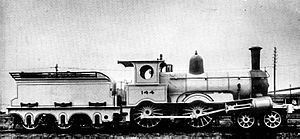New South Wales Z12 class locomotive
| New South Wales Z12 class | |||||||||||||||||||||||||||||||||
|---|---|---|---|---|---|---|---|---|---|---|---|---|---|---|---|---|---|---|---|---|---|---|---|---|---|---|---|---|---|---|---|---|---|
 Class Z12 (former Class C.79) Locomotive | |||||||||||||||||||||||||||||||||
| |||||||||||||||||||||||||||||||||
| |||||||||||||||||||||||||||||||||
| |||||||||||||||||||||||||||||||||
| |||||||||||||||||||||||||||||||||
The Z12 class was a class of 4-4-0 steam locomotives built for and operated by the New South Wales Government Railways of Australia.
History
The Z12 Class (formerly C79 and C80 class) was the first class of locomotive on the New South Wales Government Railways to be built in relatively large numbers. They hauled all express passenger and mail trains for some 20 years.
The design derives from the Metropolitan Railway A Class 4-4-0T condensing steam locomotives built for the Metropolitan Railway by Beyer Peacock in 1864. The design of these locomotives was attributed to the Metropolitan Engineer John Fowler, but the design was a development of a locomotive Beyers had built for the Spanish Tudela & Bilbao Railway, Fowler only specifying the driving wheel diameter, axle weight and the ability to navigate sharp curves.[1]
A total of 68 were built. The first batch of 30 were built by Beyer, Peacock and Company and placed in service as the 79 class between 1877 and 1879. They were the first locomotives to be imported with Westinghouse continuous air-brakes already fitted. The second batch of 26 came from Dübs and Company. These arrived between 1880 and 1881. A further four followed from Beyer, Peacock in 1881. To assist local industry, a contract for eight was awarded to the Atlas Engineering Works situated in Sydney's Haymarket and delivered in 1881–1882.[2]
Their numbers were thinned from 1895 when No. 88 was converted to a 4-4-2T tank engine for Sydney suburban service with a further 19 following by 1902. These Tank Engines were reclassified the CC79 class. The remaining engines became the C80 class.
The arrival of newer locomotives such as the D255 (later Z15), D261 (later Z16), O446 (later Z23) and P6 (later C32) classes saw them relegated to hauling secondary and later branch line services radiating out of Dubbo, Werris Creek, Narrabri and Moree, where some were equipped with cowcatchers for operation on unfenced lines. In an attempt to prevent cinders blocking the lower boiler tubes between cleanings in December 1956 an extended smokebox was fitted to 1219 with 1243 similarly modified in the 1960s.[2][3][4]
In 1924, the class was renumbered becoming the Z12 class. The Z was an ominous sign however, denoting that the class was regarded as obsolete, and the conversion of 77 C30 class suburban tank engines (made redundant by electrification) into C30T class 4-6-0 branchline engines saw withdrawals begin with 23 taken out of service between 1928 and 1933. Many of the others survived into the 1950s hauling branch line services.[4]
Demise and preservation
The first two withdrawals occurred in 1957, a further four followed in 1963.
In 1955, for the centenary of rail operations in New South Wales, 1243 was restored to its original livery. It was joined by 1210 in December 1959 and together these hauled the Vintage Train across the state.[3][4]
In January 1962, the pair hauled a special service to Canberra where 1210 and placed on display outside Canberra railway station. Having hauled the first train into the nation's capital in May 1914, 1210 had historical significance for Canberra.[3][4]
| No. | Preserved | Organisation | Location | Status | Ref |
|---|---|---|---|---|---|
| 1210 | Transferred 1962 | Canberra Rail Museum | Canberra | Under restoration | |
| 1219 | Transferred 1975 | Transport Heritage NSW | Broadmeadow | Stored | |
| 1243 | Set aside 1958 | Powerhouse Museum | Ultimo | Static display |
Gallery
-
1210 when on display outside Canberra railway station
-
Class Z1222 (C79) No.148 locomotive at the Wellington Depot (NSW)
-
Class Z12 Locomotive arriving by ship, 1876
-
NSWGR Class C.79 Class Locomotive as placed in service
-
Class Z1205 Locomotive
-
Class Z1231 Locomotive
-
1219 stored at Broadmeadow Locomotive Depot
See also
References
- ^ Goudie, Frank (1990). Metropolitan Steam Locomotives. Capital Transport. ISBN 9781854141187.
{{cite book}}: Invalid|ref=harv(help) - ^ a b Preston, Ron G (1984). Tender into Tank. Sydney: New South Wales Rail Transport Museum. pp. 11–57. ISBN 0 909862 18 4.
- ^ a b c Grunbach, Alex (1989). A Compendium of New South Wales Steam Locomotives. Sydney: Australian Railway Historical Society, NSW Division. pp. 41–45. ISBN 0 909650 27 6.
- ^ a b c d Stokes, HJW (1984). Railways of the Canberra and Monaro Districts. Canberra: Australian Railway Historical Society. p. 54.
- ^ [1]
- ^ Locomotive, steam 1219 Department of Heritage & Environment
- ^ Powerhouse Museum collection - Steam Locomotive No. 1243
Further reading
- New South Wales Steam Locomotive Data, Sydney: New South Wales Government Railways, 1966






